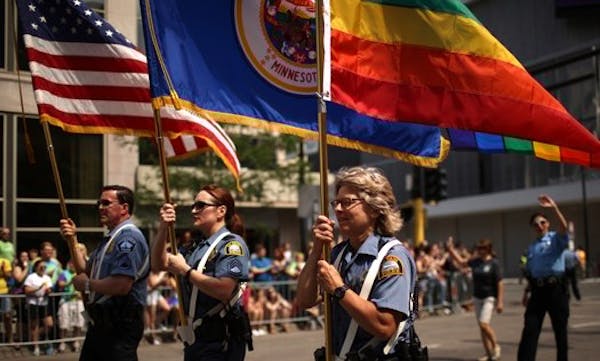Tens of thousands of people packed Hennepin Avenue in downtown Minneapolis on Sunday to cheer on the 2017 Pride parade, which proceeded with minor disruptions from protesters.
The parade, which celebrates all things LGBTQ, played out just two days after resolution of a whirlwind dispute over whether uniformed police officers should participate. After the recent acquittal of St. Anthony police officer Jeronimo Yanez in the 2016 death of Philando Castile, parade organizers had decided to exclude police, but by Friday, had reinvited them.
About a dozen uniformed officers, one with a K-9 partner, marched at the start of the parade. A half-mile behind them, two dozen officers, including Minneapolis Police Chief Janeé Harteau, who led the effort to have officers reinstated, walked along, waving to the sea of people. Several officers on bikes circled the group. Parade-goers' response was generally positive, with cheers and a few hugs for the officers.
"I think they can march," said parade-goer Saddia Washington of Champlin. "Not every police officer is a bad person. As long as they're rainbow, I'm fine."
Her friend Jasmine Looney agreed: "Gay Pride is not about hiding yourself. It's about being yourself."
But parade watcher L. Warnest of Roseville, a teacher in St. Paul Public Schools, where Castile worked before he was killed, said she was "really torn."
"I feel police do a really good job in the schools, [but] I supported the original decision [to exclude police], and I don't really appreciate them overturning it," she said. "Pride started out because of police brutality. I believe Yanez should be in jail. If police are brutalizing people of color in our state, it's hard to want to celebrate them."
Joe Brown and Lashonda Brown of Inver Grove Heights and Kahlilah Armstrong of West St. Paul agreed. "They don't need to march," Armstrong said. "They can sit down on that one."
Don Jones and Bob Driscoll of Minneapolis, who were celebrating their 20th anniversary as a couple and who married last year, said the parade's long-standing stance of broad inclusion should prevail. "I think they should march, period," Driscoll said of police.
The welcome was cool but peaceful for about 75 protesters who streamed onto Hennepin near 10th Street and briefly blocked subsequent intersections ahead of the parade, causing several slowdowns. The protest group, some of whom wore rainbow garb, carried a "Justice for Philando" banner and shouted slogans that included, "No justice, no peace, no pride in police!" A leader shouted a list of demands for Pride organizers into a microphone.
But most spectators toward the front of the parade, which started at 3rd Street, were unaware of the protesters, assuming that the brief stops were caused by stoplights.
Eventually the protesters moved about two blocks ahead of the parade and headed toward Loring Park, where the Pride Festival was underway. No one was arrested, according to police spokesman Corey Schmidt.
Pride, passion, protests
There was plenty to see at the spectacularly colorful parade. A young girl did cartwheels and splits as she marched down Hennepin. Some parade marchers carried Black Lives Matter signs. One group carried signs that said, "Queer Muslims Exist" and "Muslims Against Homophobia." Balloons were everywhere. With temperatures in the high 50s and low 60s for most of the parade, there was far more clothing than in previous years, although there was lots of skin showing, too.
Many politicians walked the route, some of them campaigning. They included Senators Amy Klobuchar and Al Franken; U.S. Rep. Tim Walz, who is running for governor; Minneapolis Mayor Betsy Hodges, St. Paul Mayor Chris Coleman and many others.
Meanwhile, near the parade's starting point at Hennepin and 3rd Street, a woman went into labor and gave birth with help from emergency responders, according to police scanner reports.
The LGBTQ event has often served as the local ground zero for expression of views about broader cultural issues. Last year, it provided a place to mourn for the victims of the recent gay nightclub massacre in Orlando. In 2013, it was the focal point of celebration over Minnesota's legalization of same-sex marriage. And in the years before that, it was a place to campaign for that right and others, and to challenge bias and homophobia.
After the parade, Harteau tweeted her thanks to those who welcomed her and other officers. "Filled with PRIDE for the warm reception and the love given to us today!" she wrote. "Love this community."
Staff journalists Claude Peck and Glen Stubbe contributed to this report. Pat Pheifer • 612-673-7252

A tale of 124 hoarded Minnesota cats has at least a hundred happy endings

Walz, St. Paul leaders urge support for copper wire theft bill: 'We've got to get in front of it'
Body of missing canoeist, 15, recovered from southwest Minnesota lake

High winds flipped a FedEx truck traveling on Bong Bridge in Duluth

